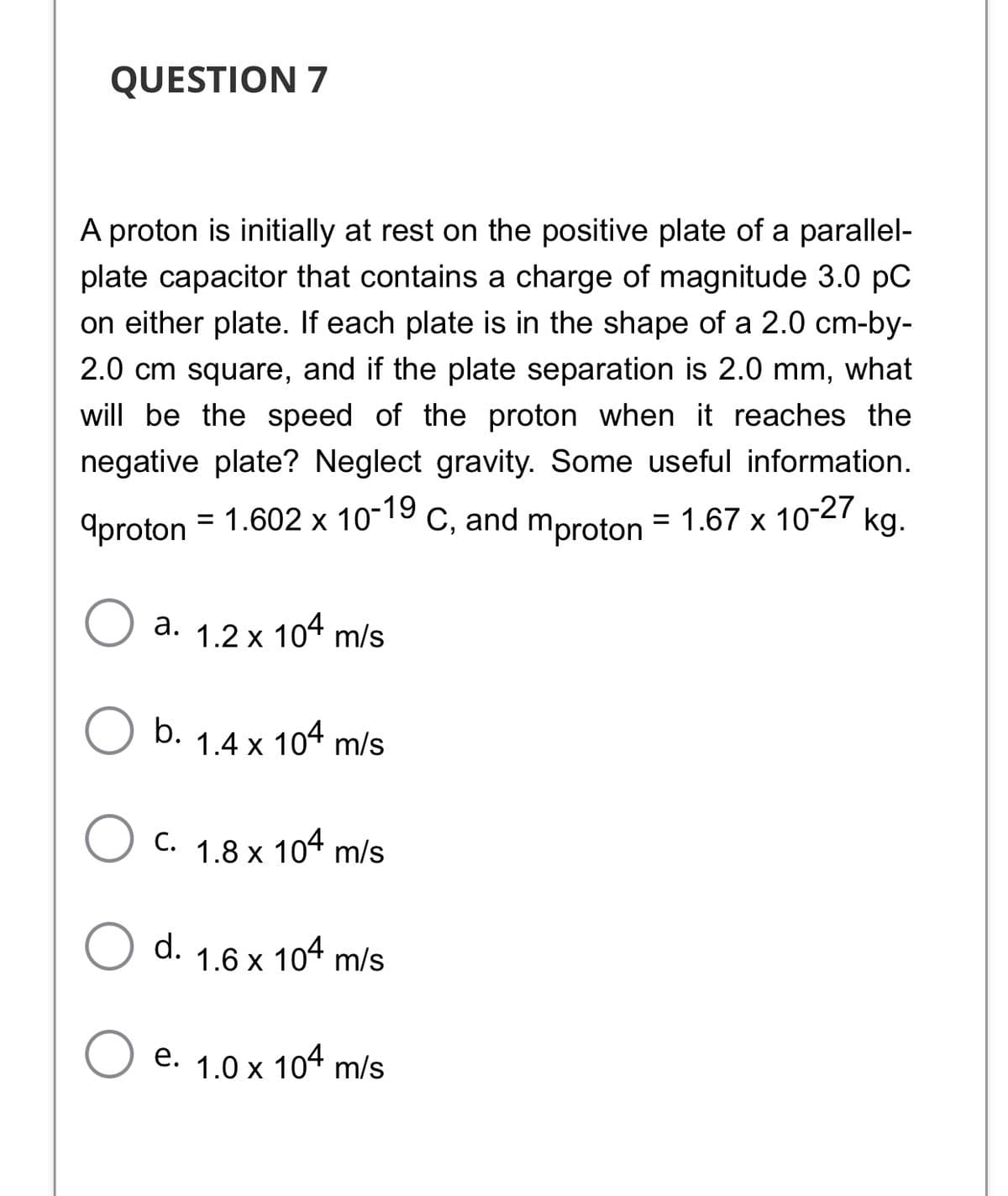A proton is initially at rest on the positive plate of a parallel- plate capacitor that contains a charge of magnitude 3.0 pC on either plate. If each plate is in the shape of a 2.0 cm-by- 2.0 cm square, and if the plate separation is 2.0 mm, what will be the speed of the proton when it reaches the negative plate? Neglect gravity. Some useful information. qproton = 1.602 x 10"19 C, and mproton = 1.67 x 10-27 kg. %D a. 1.2 x 104 m/s b. 1.4 x 104 m/s C. 1.8 x 104 m/s d. 1.6 x 104 m/s e. 1.0 x 104 m/s е.
A proton is initially at rest on the positive plate of a parallel- plate capacitor that contains a charge of magnitude 3.0 pC on either plate. If each plate is in the shape of a 2.0 cm-by- 2.0 cm square, and if the plate separation is 2.0 mm, what will be the speed of the proton when it reaches the negative plate? Neglect gravity. Some useful information. qproton = 1.602 x 10"19 C, and mproton = 1.67 x 10-27 kg. %D a. 1.2 x 104 m/s b. 1.4 x 104 m/s C. 1.8 x 104 m/s d. 1.6 x 104 m/s e. 1.0 x 104 m/s е.
Physics for Scientists and Engineers, Technology Update (No access codes included)
9th Edition
ISBN:9781305116399
Author:Raymond A. Serway, John W. Jewett
Publisher:Raymond A. Serway, John W. Jewett
Chapter26: Capacitance And Dielectrics
Section: Chapter Questions
Problem 26.8P
Related questions
Concept explainers
Dielectric Constant Of Water
Water constitutes about 70% of earth. Some important distinguishing properties of water are high molar concentration, small dissociation constant and high dielectric constant.
Electrostatic Potential and Capacitance
An electrostatic force is a force caused by stationary electric charges /fields. The electrostatic force is caused by the transfer of electrons in conducting materials. Coulomb’s law determines the amount of force between two stationary, charged particles. The electric force is the force which acts between two stationary charges. It is also called Coulomb force.
Question

Transcribed Image Text:QUESTION 7
A proton is initially at rest on the positive plate of a parallel-
plate capacitor that contains a charge of magnitude 3.0 pC
on either plate. If each plate is in the shape of a 2.0 cm-by-
2.0 cm square, and if the plate separation is 2.0 mm, what
will be the speed of the proton when it reaches the
negative plate? Neglect gravity. Some useful information.
9proton = 1.602 x 10-19
C, and mproton =
= 1.67 x 10-27 kg.
a. 1.2 x 104 m/s
b. 1.4 x 104 m/s
С.
1.8 x
104 m/s
d. 1.6 x 104 m/s
е. 1.0х 104 m/s
Expert Solution
This question has been solved!
Explore an expertly crafted, step-by-step solution for a thorough understanding of key concepts.
This is a popular solution!
Trending now
This is a popular solution!
Step by step
Solved in 2 steps with 2 images

Knowledge Booster
Learn more about
Need a deep-dive on the concept behind this application? Look no further. Learn more about this topic, physics and related others by exploring similar questions and additional content below.Recommended textbooks for you

Physics for Scientists and Engineers, Technology …
Physics
ISBN:
9781305116399
Author:
Raymond A. Serway, John W. Jewett
Publisher:
Cengage Learning

College Physics
Physics
ISBN:
9781305952300
Author:
Raymond A. Serway, Chris Vuille
Publisher:
Cengage Learning


Physics for Scientists and Engineers, Technology …
Physics
ISBN:
9781305116399
Author:
Raymond A. Serway, John W. Jewett
Publisher:
Cengage Learning

College Physics
Physics
ISBN:
9781305952300
Author:
Raymond A. Serway, Chris Vuille
Publisher:
Cengage Learning


College Physics
Physics
ISBN:
9781285737027
Author:
Raymond A. Serway, Chris Vuille
Publisher:
Cengage Learning

Principles of Physics: A Calculus-Based Text
Physics
ISBN:
9781133104261
Author:
Raymond A. Serway, John W. Jewett
Publisher:
Cengage Learning

College Physics
Physics
ISBN:
9781938168000
Author:
Paul Peter Urone, Roger Hinrichs
Publisher:
OpenStax College